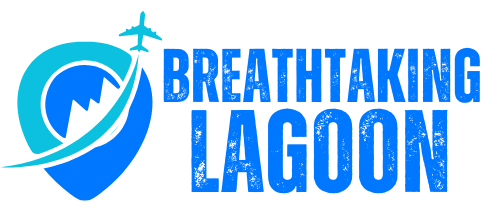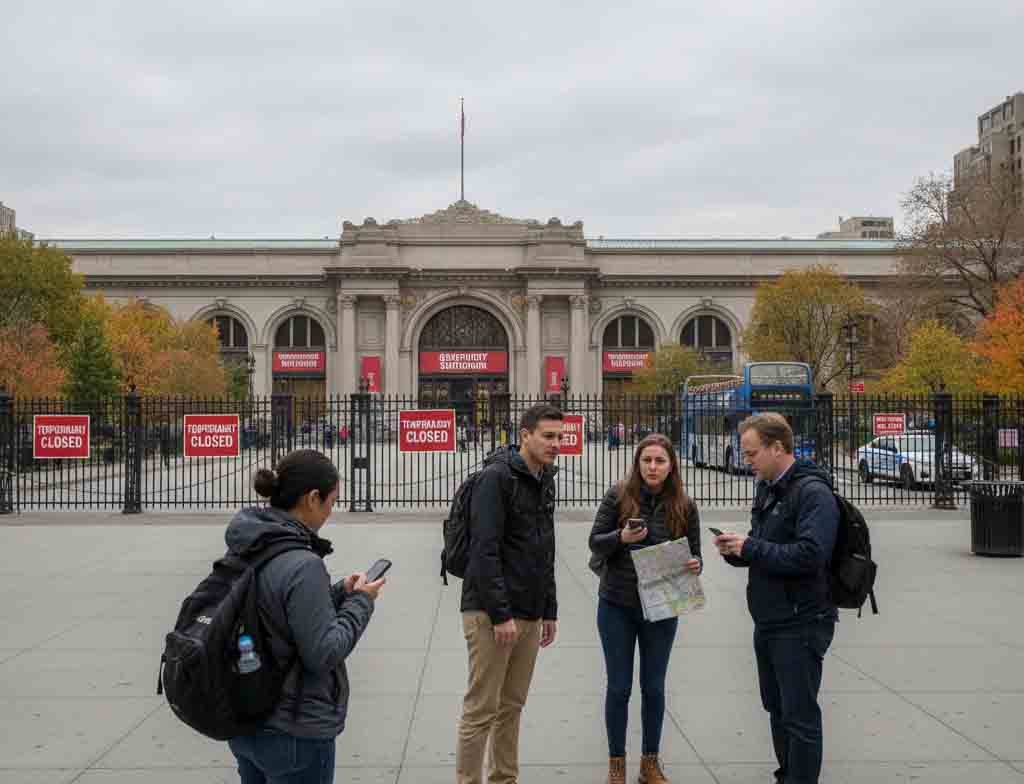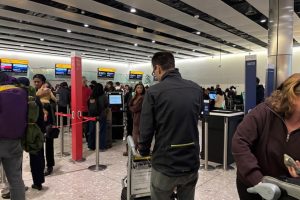Published on October 5, 2025
By: Tuhin Sarkar
This October, major US cities such as New York, Las Vegas, Los Angeles, and many more are facing significant disruption as the American travel industry struggles amid the ongoing government shutdown. The shutdown has caused massive delays, cancellations, and closures of popular tourist attractions and services, leaving both domestic and international visitors frustrated. The disruption is especially noticeable in cities like New York, Las Vegas, and Los Angeles, which depend heavily on tourism. Additionally, Canadian tourists are ditching their travel plans to the US, further exacerbating the challenges facing the travel industry. With fewer international visitors, especially from Canada, the American travel industry is experiencing a sharp decline in revenue. The latest update indicates that both tourists and local businesses are feeling the impact of these changes. As the shutdown continues, it remains to be seen how these cities and the broader US tourism sector will recover.
American Cities like New York, Las Vegas, and Los Angeles, known for their bustling tourism sectors, are seeing a drop in visitor numbers. The government shutdown has forced many federally funded attractions, including museums, national parks, and cultural sites, to close their doors. This not only affects tourists but also puts local businesses in a tough spot, especially those relying on the influx of visitors.
Advertisement
Advertisement
The situation has worsened with a notable increase in Canadian tourists ditching their trips to the US, adding to the already growing concern within the US tourism industry. Factors like strained relations between the two countries, along with the shutdown, have led to a massive decline in cross-border tourism. The US tourism industry now faces a perfect storm of challenges, with both domestic and international visitors rethinking their travel plans. In the coming months, the future of US travel will depend on how quickly the shutdown ends and how the industry adapts to these sudden changes.
The US government shutdown in October 2025 has caused ripples across the tourism sector, impacting national parks, major tourist destinations, and local economies. With millions of tourists visiting the US every year, the shutdown has dramatically affected their travel plans. National parks and iconic tourist attractions have been forced to close or limit services, creating confusion and frustration. This article will explore how the US shutdown has affected US tourism on a state-by-state basis, highlighting the impact on key cities and regions and examining what the future may hold for the tourism industry.
The Immediate Impact of the US Shutdown on Tourism
The US tourism industry is a significant contributor to the country’s economy, generating billions of dollars every year. However, the October 2025 shutdown has led to disruptions in travel, particularly in national parks and other federally funded sites. With over 9,000 furloughed employees at the National Park Service (NPS), many parks have been forced to close or reduce services. This has not only disappointed visitors but also harmed local economies that rely heavily on tourism.
National Parks Affected by the Shutdown
National parks across the US have felt the brunt of the government shutdown. These parks, which attract millions of visitors annually, are essential to US tourism. In states like California, Utah, and Arizona, the shutdown has caused major disruption to park operations. While some parks remain open, the lack of rangers, tour guides, and other staff members has made it difficult to maintain services.
Advertisement
Yosemite National Park, California
Advertisement
Yosemite National Park, one of the most popular parks in the US, has remained open but with limited services. Many visitor centres have been closed, and ranger-led programs have been cancelled. Visitors still have access to trails and open areas, but the full Yosemite experience is compromised. The lack of staff means fewer resources for tourists, and safety concerns have been raised due to the absence of trained personnel on-site.
Zion National Park, Utah
Zion National Park, famous for its stunning canyons and scenic views, has also been impacted by the shutdown. Although the park is open, it is operating with reduced staff. Park rangers are unavailable to guide visitors, and key services, including restrooms and information booths, are closed. The lack of funding has led to a backlog in park maintenance, creating a less than ideal experience for visitors. Utah’s tourism office has stepped in to help cover some costs, but this is not a long-term solution.
Grand Canyon National Park, Arizona
The Grand Canyon, one of the most iconic landmarks in America, has experienced similar issues. The park remains open, but services are limited. The absence of federal workers means that many visitor programs are unavailable. Arizona’s state government has been forced to step in to help maintain some level of service, but it has struggled to keep up with the demand. The Grand Canyon is a major economic driver for Arizona, so the impact of the shutdown on local businesses has been significant.
Air Travel and Airports Affected by the US Shutdown
While the national parks have been in the spotlight during the shutdown, air travel and airports across the country have also been impacted. The shutdown has caused disruptions in airport security and air traffic control operations, leading to delays and longer waiting times for passengers. The Federal Aviation Administration (FAA) has had to furlough workers, and TSA agents have been working without pay. This has created concerns about the safety and efficiency of airport operations, especially during peak travel periods.
Impact on Major Airports
Airports in major US cities like New York, Los Angeles, and Chicago have been particularly affected. The lack of staff has led to longer security lines, flight delays, and cancellations. This has caused frustration for travellers and businesses alike. Airlines have reported a decline in bookings, particularly from international tourists, due to the uncertainty created by the shutdown. The travel industry as a whole is bracing for further losses if the shutdown continues.
Economic Losses in the Travel Industry
The US travel industry is estimated to lose around $1 billion every week during the shutdown. This includes losses from national parks, airports, hotels, and other travel-related businesses. For example, Las Vegas has reported a decline in visitor numbers, as the shutdown has disrupted travel plans and discouraged international visitors. The tourism industry is facing a severe downturn, and local economies dependent on tourism are feeling the pressure.
Museums and Cultural Sites: A Major Blow to US Tourism
Cultural sites and museums across the US, many of which are federally funded, have also been hit by the shutdown. In Washington D.C., iconic sites like the National Mall, the Lincoln Memorial, and the Washington Monument have been affected. While outdoor areas remain open, indoor facilities such as the Smithsonian museums have been closed, depriving tourists of the full experience. This has particularly impacted international visitors, who often come to the US to explore its rich history and culture.
Washington D.C.: A City in Crisis
Washington D.C., the nation’s capital, is particularly vulnerable to the effects of the shutdown. As a hub for both domestic and international tourists, the city relies heavily on tourism revenue. With key cultural sites closed and national monuments off-limits, the impact on the city’s economy has been significant. Local businesses, including hotels, restaurants, and tour operators, are struggling to stay afloat as visitor numbers drop. While some private institutions have remained open, many tourists are opting to delay or cancel their trips to D.C. until the shutdown ends.
Florida: Decline in Canadian Visitors and Strained Relationships
Florida, a top destination for Canadian tourists, has also seen a decline in visitors. In 2024, approximately 3.3 million Canadians visited Florida, contributing significantly to the state’s economy. However, with the US-Canada relations strained due to increased tariffs and political tensions, Florida has experienced a 60% drop in Canadian tourists. This has impacted major attractions, including Disney World and the Everglades, and local businesses are facing financial losses. Tourism in Florida relies heavily on Canadian visitors, and this decline has raised concerns about the future of the state’s tourism industry.
Las Vegas and Los Angeles: Tourism Slumps Amidst Economic Pressures
Both Las Vegas and Los Angeles are seeing declines in tourism due to the US shutdown and other economic factors. Las Vegas, in particular, has experienced a 7.8% decrease in visitor numbers, with Canadian tourists dropping by 20%. Similarly, Los Angeles, especially Hollywood, has seen a 50% drop in visitors. The economic pressures caused by the shutdown, combined with factors like wildfires and political unrest, have significantly affected the tourism industry in both cities.
Hawaii: Shifting Focus Towards Sustainable and Regenerative Tourism
Hawaii, which has long been a popular destination for US and international tourists, is shifting its focus towards sustainable and regenerative tourism. The Hawaiian government and local communities are increasingly promoting tourism that prioritises environmental sustainability and cultural preservation. Native Hawaiians are leading this movement, encouraging visitors to respect the land and its traditions. Despite challenges such as wildfires and declining visitor numbers, Hawaii is committed to reshaping its tourism model to benefit both residents and visitors. The focus is on creating a more sustainable and respectful tourism experience for all.
The Future of US Tourism: What Lies Ahead?
The future of US tourism hinges on how quickly the US government shutdown is resolved and how the tourism industry adapts to the ongoing challenges. National parks, airports, and cultural sites need immediate funding and support to get back to normal. The tourism industry as a whole is facing significant financial losses, and local economies that depend on tourism are at risk. The US travel industry must work together to find solutions that will allow it to recover from the effects of the shutdown.
Conclusion: The Long Road to Recovery for US Tourism
The US shutdown has had a far-reaching impact on the country’s tourism industry. From the closure of national parks to the disruption of air travel and the shutdown of cultural sites, the effects have been felt across the nation. While some areas have taken proactive steps to mitigate the damage, it will take time for the tourism industry to fully recover. The shutdown has also highlighted the vulnerability of the US tourism industry and the need for long-term solutions to support it during times of crisis.
In conclusion, the US tourism industry faces a long road to recovery. The shutdown has disrupted travel plans, hurt local economies, and caused significant losses for businesses dependent on tourism. The US government, tourism boards, and local communities must work together to find solutions and rebuild the industry. Only then can the US regain its status as one of the world’s most visited tourist destinations.
Advertisement
Tags: American tourism disruption, canadian tourists, Las Vegas Travel, Los Angeles Tourism, New York Tourism
Advertisement
Tags: American tourism disruption, canadian tourists, Las Vegas Travel, Los Angeles Tourism, New York Tourism
I want to receive travel news and trade event update from Travel And Tour World. I have read Travel And Tour World’sPrivacy Notice.
Sunday, October 5, 2025
Sunday, October 5, 2025
Sunday, October 5, 2025
Sunday, October 5, 2025
Sunday, October 5, 2025
Saturday, October 4, 2025
Sunday, October 5, 2025
Sunday, October 5, 2025




